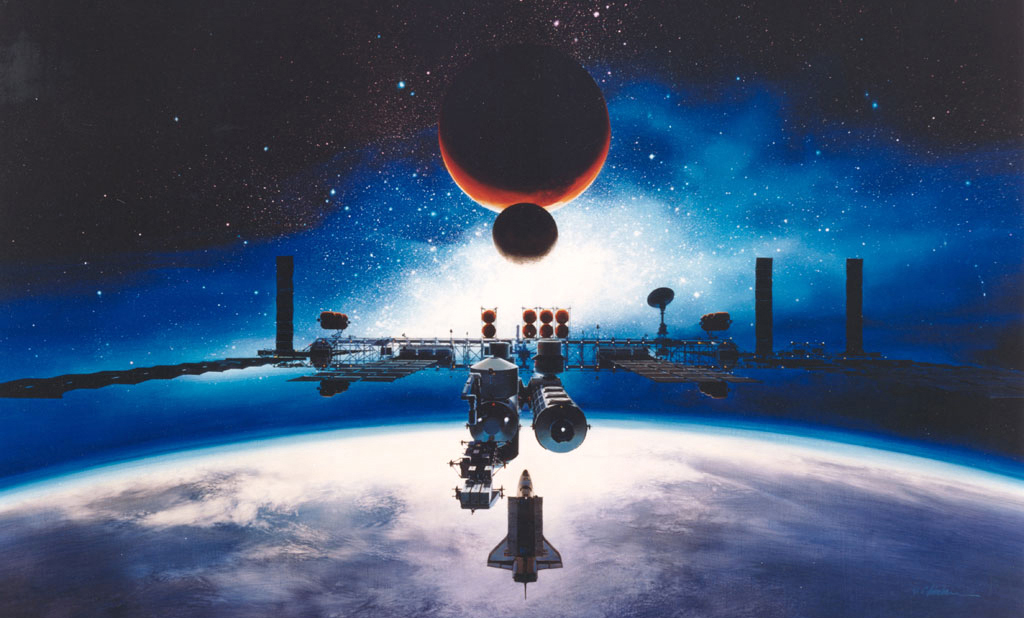
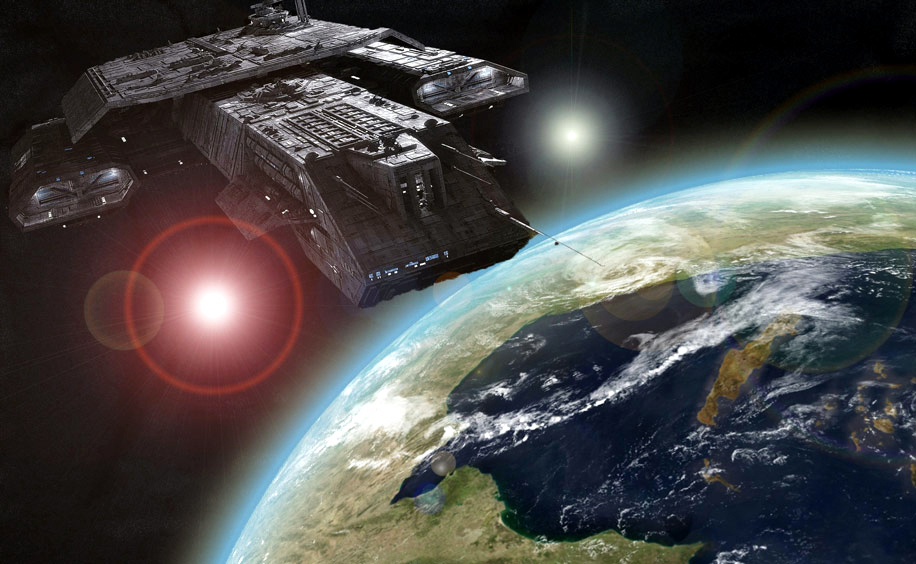



従前よりの主たる宇宙推進技法としては、専ら、(外界と質量の交換をしない)閉じた系に、 外部からの力が加わらない限り、その閉鎖系の運動量の総和は、不変であるという運動量保存則に従って、 概ね、ある系内から、(ロケット燃料等の)推進剤となるものを(外力と見なせるように)外部へ噴き出しつつ、 その反動(反作用)により、推進力を得るものがほとんど、占め、 別段、(外力によって作用されない)閉じた系に属する密閉空間(密閉容器)内での圧力差を応用した (燃焼ガスを外部へ噴出しない)推進機器にあっては、 上述の通り、理論的な理由により、実用上、歴然と新規開発(有効活用)されていないのが現状です。
しかしながら、そもそも、かの閉じた系等に関する定義につき、よくよく考慮すれば、 その系内に、何らかの流体・流動性の物質(水等)を含んでいるものでさえ含めて、 運動量保存則を適用することなど出来ません。
なぜなら、それ自体、密閉容器内で静止している非圧縮性流体の1点で、 (外部からの力による)圧力の増加があると、同流体内の全ての各点で(どの方向点でも)、 同じ大きさの圧力の増加が見られるというパスカルの原理を理解すれば、ほぼ容易に判断できます。
要するに、運動量保存則に準じた(流体静力学上の)パスカルの原理が通用し得るのは、 さほど、(同保存則が通用しない外部からでなく、内部からの力による)圧力を加えられた流体自体、 あくまでも、静止状態の場合に限られ、 以て、さしたる密閉容器内に、予め、適量の流動性物質を入れ、その流体中に、 (自動操作・遠隔操作等で)系内の1点に力を加えても、同容器内の他(の複数)点の方へ、 常に同じ強さの力が加わらなければならないという絶対的な道理などなく、 従ってそれ故、さしたる流動中に、同上容器の両端云々にかかる(流体動力学上の) ベルヌーイの定理に準じた圧力(内圧)差を生じさせれば、いみじくも、(宇宙船体と見なせる) 同容器・中空体自体、運動方程式・運動の第2法則に則って、(弱力・弱圧でなく)強力・強圧なる方向へ、 難なく移動(推進・前進)し得ると云っても過言ではないのです。
@注:ベルヌーイの定理は、力学的エネルギー保存則に相当するものの、 必ずしも、運動量保存則を前提としていないことに留意されたし。
■【補記】
*運動の第1法則(既定の日本語意訳)
すべての物体は、外部から力を加えられない限り、静止している物体は静止状態を続け、
運動している物体は等速直線運動を続ける。
*運動の第1法則(流体動力学等を考慮した)改訂版
すべての物体(その体内に、流動性物質を含む中空体を除く)は、外部から力を加えられない限り、
静止している物体は静止状態を続け、運動している物体は等速直線運動を続ける。
<熱力学上等の留意点>
上記の運動量保存則に関した閉鎖系の概念(定義)にかけて、
概ね、同上法則が適用できる閉鎖非流体系と適用できない閉鎖流体系の二系統に大別されることを
前置いた上で、概略的にも下記を付記する。
@既定の熱力学第一法則(エネルギー保存則)
系(閉鎖系)の内部エネルギー の変化は、外界から系に入った熱と外界から系に対して行われた仕事の和に等しい。
上記の改訂版として、
*系(閉鎖非流体系)の内部エネルギーの変化は、外界から系に入った熱と外界から系に対して行われた仕事の和に等しい。(平衡熱力学)
*系(閉鎖流体系)の内部エネルギーの変化は、外界から系に入った熱と外界から系に対して行われた仕事の和に必ずしも等しくない。(非平衡熱力学)
本閉鎖流体系に属する密閉容器(中空体)内には、概ね、下記の方法通り、 当該エンジン作動中、絶えず、空気and/or水を特定の部位に圧する(留まる)ことなく、適度に循環させている為、 殊の外、圧力(内圧)差から生じる運動エネルギー(又は運動量)の全てが、 同容器内の両端云々にかかる圧力損失、即ち、摩擦(損失)による熱エネルギーに変換することなど有り得ず、 従ってそれ故、本システム稼働中に、関係装置の内部で、何らかの摩擦熱(摩擦力)が生じようとも、高々、圧力(内圧)差生成(起因)による推力を阻む程ではなく、 さしたる宇宙推進にかけて、それほど、影響を及ぼすものではありません。
尚、関係装置に、この仕事を行なう部分を組み込んだ本推進体(外界に熱を放出できる閉鎖流体系)自体、 別して、その仕事によって発生した熱を同装置内の熱源に回収する機構等々、全く、不要な為、 既定の(実現不可能とされる)第二種永久機関等に該当しないことなど、勿論、言うまでもありません・・・云々。
■ [The Supplement]
In a closed system (one that does not exchange any matter with its surroundings
and is not acted on by external forces and does not allow certain types of transfers
in or out of the system),
the total momentum is constant. (the momentum conservation law)
However, just inside a closed fluid system that does allow certain types of transfers
(such as transfer of mass and/or matter) in the closed system of a hollow type,
the total momentum is "variable". (the momentum non-conservation law)
So, Pascal's (first) law is defined as
A change in pressure at any point in an enclosed fluid at rest is transmitted undiminished
to all points in the fluid.
And Pascal's second law (or King O's principle) may be defined as
A change in pressure at a point in an enclosed fluid not at rest is transmitted increasing
(and/)or decreasing to any other point(s) in the fluid.
Therefore, the hollow body (as a spaceship body) in the closed fluid system must always move forward
(or backward) in case of being able to cause pressure difference by the fluid at both ends (etc) of its body,
just considering Bernoulli's principle that does not necessarily base on the law of momentum conservation
and that corresponds to the law of the conservation of energy yet.
[The Consequence]
An object of hollow structure (that does allow certain types of transfers in its body)
can be moved itself by an inner force (not an internal force in the action-reaction law)
resulting from internal pressure difference without external forces (from the outside of the body).
*King O's law of internal motion (by Kingo Ueuchi)
簡潔ながらも、以上の技能的な事由を踏まえ、さほど、閉鎖流体系に属する中空体内にかけて、 当の圧力(内圧)差を生成させることができる数通りの独特的な方法を概ね、以下の通り、提示(列挙)した次第です。
■<ウォータージェット推進(高水圧)方式の宇宙推進(圧力差推進)システム>
*先ず、さしたる中空体に、(本推進剤の代用となる)水等の液体などを入れ、
順次、同体付属の強力ポンプ類により、噴流を起こしつつ、とりわけ、その反動を推力とする場合、
至当のごとく、その流体が、後方の壁面(内壁)に当たって、前進力と(ほぼ)同等程度の後進力が掛かってしまいますが、
如何せん、殊の外、それを阻止する為には、概ね、以下の通り、要所にそれ相当、効力のあるウォーターバリアを敷いて、
さしたる噴流を同上壁面との接触前に極力、遮断すればよいのです・・・・云々。
[THE WATER (PUMP) JET PROPULSION VERSION]
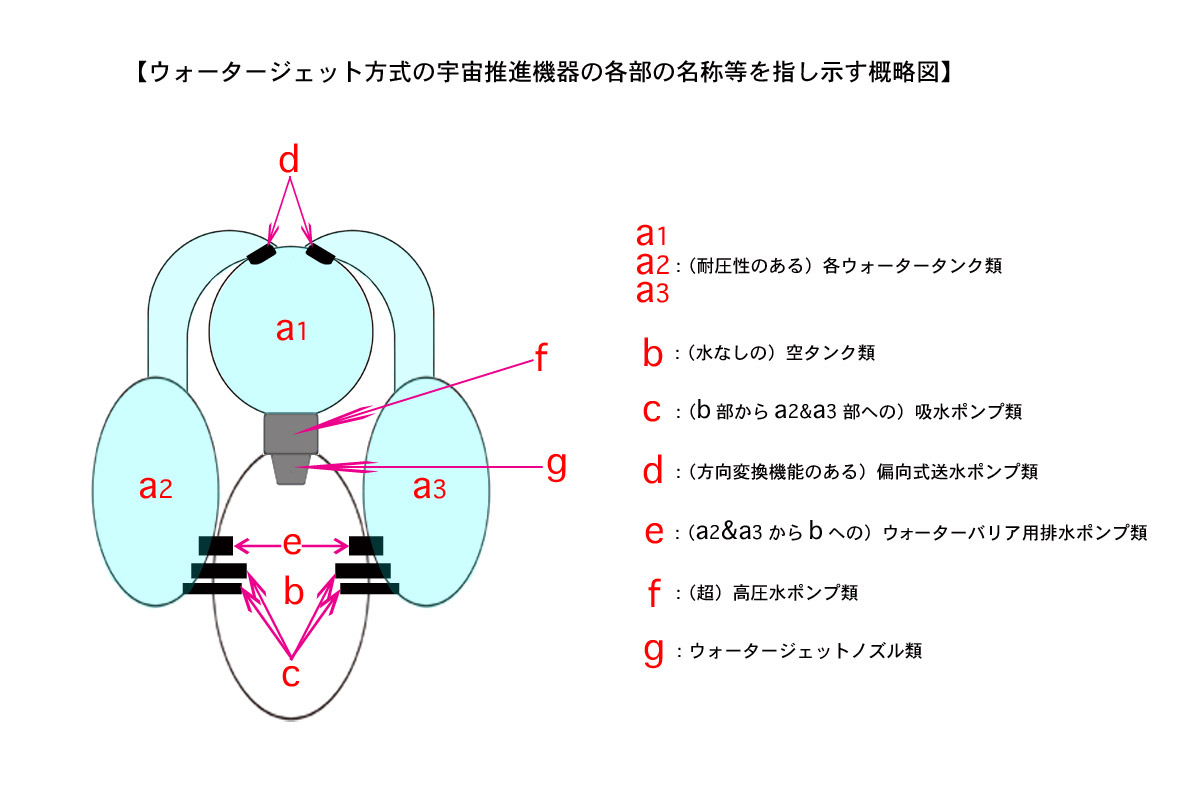 <本圧力差推進の生成方法>
<本圧力差推進の生成方法>
1:先ず、本体上部(前部)のウォータータンク(a1)に溜め込んだ水を所定の高圧ポンプ(f)と連結する
ウォータージェットノズル(g)から、(水なしの)空タンク(b)の方へ噴き出す。
2:前述通りの水の噴流が、本体下部(後部)の空タンクの壁面(内壁)に当たらないよう、両側から、
排水ポンプ(e)を稼働させることにより、後進力阻止用のウォーターバリアを直ぐさま、築く。
3:上述のウォーターバリアを敷くと共に、空タンク内に、水が溜らないように、各々の吸水ポンプ(c)にて、
bタンクから、a2&a3両タンクへと即、流水・送水させる。
4:然して、ウォータージェット噴流による反動から生じた、本体の前進方向(上方)にかかる強圧と
効力のあるウォーターバリアにより、極力、抑えられた、同体の後進方向(下方)にかかる弱圧との差異により、
本体自体、推力が少なからず、生じる。
5:尚も、後々、さしたる有効的な水循環(ウォーターサイクル)を(電力等が尽きない限り)絶えず、繰り返せば、
よもや、宇宙空間(無重力空間)では、本機自ら、(夢の)超高速・準光速に達し得るものとも・・・・。
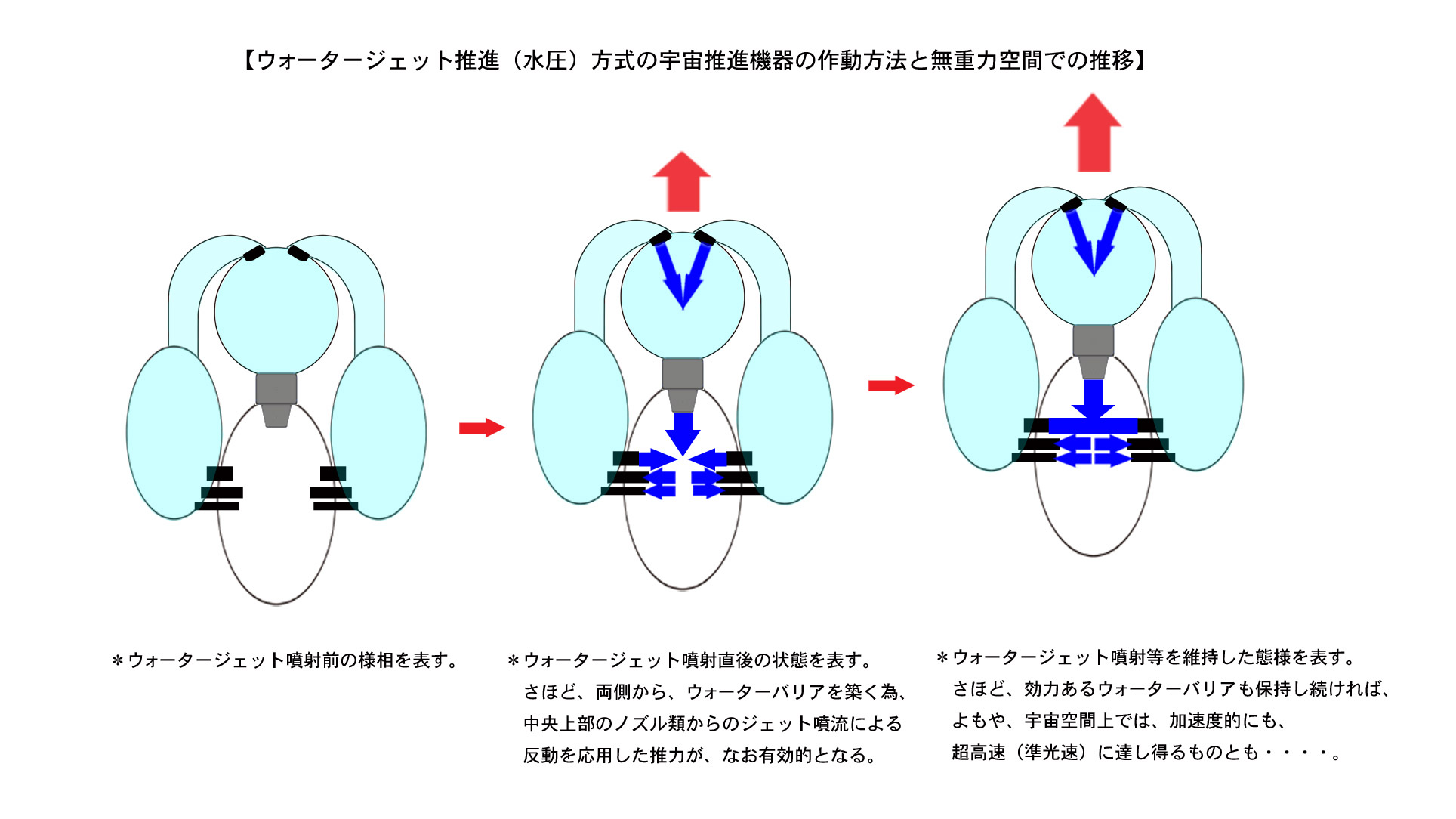 〜・〜・〜・〜
〜・〜・〜・〜
且つ又、上記のウォータージェット推進方式以外にも、本推進剤の代用となる水を(圧縮)空気に置き換えた
エアジェット方式、或いは、高圧水と圧縮空気を混合させた(超)高圧水ロケット方式等々の応用バージョンが、
色々と考えられます。
■【本圧力差推進の他の生成方法】
本推進体(中空体)の内部にある主要な流動性物質を別段、なお質量が大きい(重量が重い)鉄球類に置き換え、
適時、その鉄球を同体内で適度に射出させつつ、いみじくも本体の両端云々にかかる、同体と鉄球との衝突角度を変えることなどにより、
圧力(内圧)差を生じさせた技法にかけては、概して、以下の通りです。
*同上体と射出球との衝突に際しては、概ね、片方では(完全)弾性衝突、もう片方では、主に完全非弾性衝突になる所存です。
[The Way of the other Space Propulsion System]
First, according to the following Fig.1, two (or a more even number's) iron balls (a) with large mass
are shot simultaneously from each shooting device (d) of an electromagnetic type etc
in vertical directions against any propulsion direction,
not to cause backing power as reactions of the above shooters to the utmost.
Secondly, just after the iron ball's passing through each corner curve (on an angle of 45 degrees)
in an elastic tube rail of plural ones (b), the spherical shot body in a non-contact state with the main body (c)
does cause a completely inelastic collision with the nose (the end) with an electromagnet apparatus of the main (hollow) body.
Thirdly, it may be always repeated (restricken) from the beginning shot many times,
recovering the iron balls to the same ball shooters slowly without causing the backing force
by utilizing the shooting ball recovery equipments (f) right after cutting power supply for the electromagnet temporarily (for the moment).
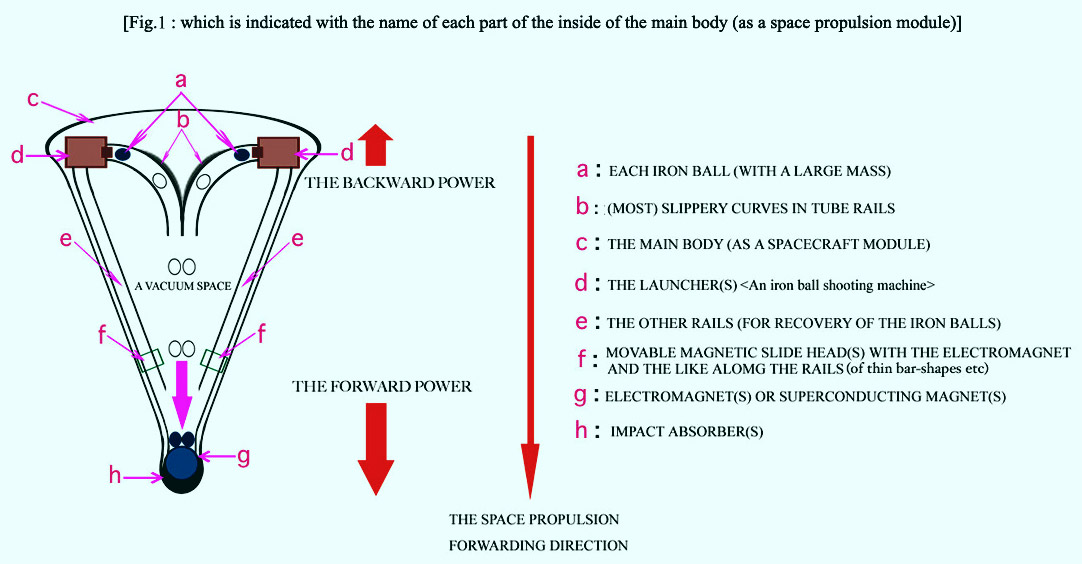
[The theoretical formula]
An equation of momentum conservation in the perfectly inelastic collision
between the main body and the spherical body after passing through the curve is...
m1v1 + m2v2 = (m1+m2)v3
m1 : The iron ball’ mass (per shot ball)
v1 : The same ball’s velocity (after its passing through the tube rail’s curve)
m2 : The main body’mass (without the above ball)
v2 : The main body’s velocity (involved the backward force just after the ball’s passing through...)
v3 : The united body (a spacecraft module body)’s velocity
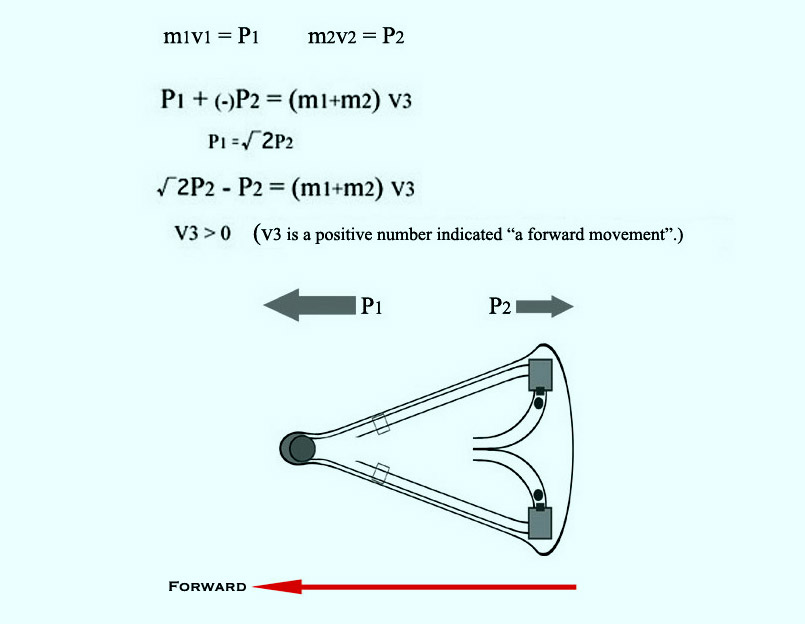
[The Experimental Method (on the ground)]
This ground experiment purpose is to examine (research) whether the main body (A) moves (works) surely (really) when the completely inelastic collision occurs
between the same body (A) & the spherical body (B)
as shown in each simple design (Fig.3) of the below,
and then, the following accurate (computable) distance (x) that the united body moved actually from the first position of the same body to its last position could be calculated from the value of v3 (m/s).
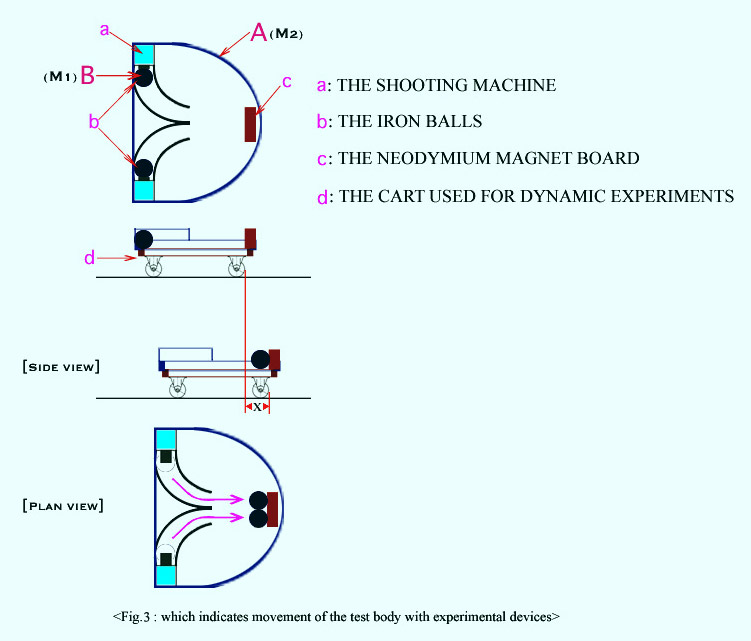
*In case of the ground experiment with the temporary equipment module, a (little) backward force would have been exerted on the main body (A).
Because the spherical body (B) always comes into contact with the above body (A) up to the collision between the iron ball(s) & the neodymium magnet board, however, in case of the space flight with this spacecraft propulsion module, the A body & the B body are in a non-contact state after each iron ball's passing through the tube's curve...
[The Experiment Data]
“Proof (example) is better than argument (precept).”
First of all, please see scientific experiments in the following movie files (DS1.AVI & DS2.AVI & DS7.AVI) fairly by the third party, not by intention of the inventor (the author).
Note : Each main body in the DS1 and/or DS2 which weight is more than 150g could move slightly but surely.
***The movement has never been done by a frictional force from a ground surface,
because of no power unit (for transmission gear) to directly turn wheels of a cart used for dynamic experiments.
As for the experimental results, it’s been all the same as the above movement in (re)testing many times.
Indeed, it could have been shown by means of evidence that thrust force of the spacecraft propulsion engine system is incomparably larger than thrust one of ion engines which can move only a thing (1g) on the ground.
And then, the same body would stop straightaway by that friction on the ground, however, it could certainly show uniform motion!! in the universe.
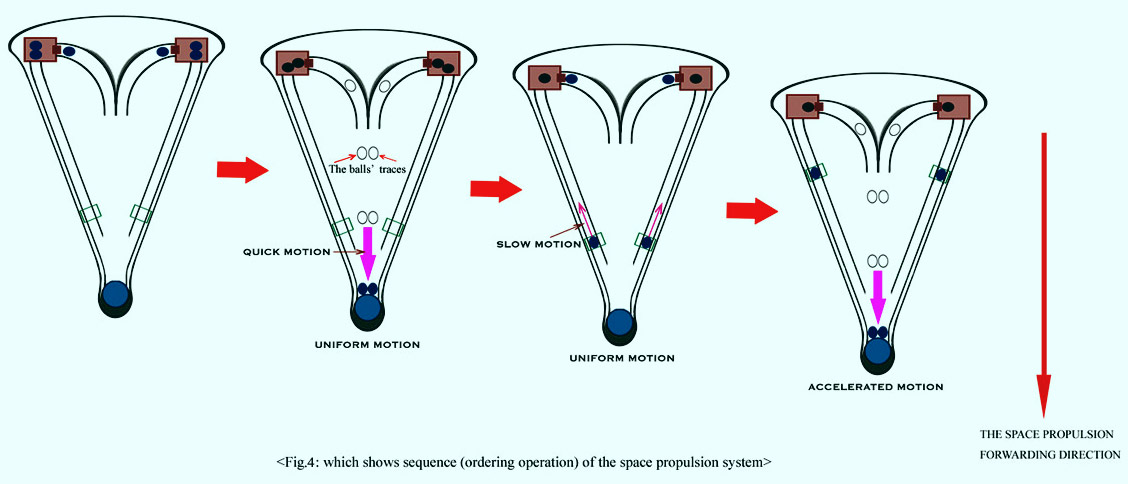
Moreover, it will be able to approximate to a dream-like superspeed (semi-light speed) by reusing repetitively some inducing substance (the iron ball...) which is not disposable just like rocket fuels.
[Supplementary Explanation]
If someone is still doubtful as to the above experimental results
just like a magic trick that can deceive one's eyes....,
shall anyone try a thought experiment
without using these experiment tools with the express purpose?
In the first place, imagine that an iron ball (A) which is large (about 7kg and over) in mass
like a shot of athletics and a neodymium magnet ball (B) which its mass is small (about 0.005kg) are floating in a (universe) gravity-free space.
In the second place, let's assume that the A body with velocity faster than B from the right side hits
the B body with velocity slower than A from the left side.
What will become of the corporate body at all?
Of course, the above united body does uniform motion, not at rest
in the direction of the left side from the right side.
This space propulsion system has applied that motion no doubt!!
The point is to take advantage of pressure difference effectively
at the perfectly inelastic collision and then, it is possible to move forward so smartly....
■【本宇宙推進機の更なる応用版】
本推進体(その推進方式は、主にエアジェットタイプ)に、(水素又はヘリウム)ガス気球等と組み合わせ、長期滞空可能な複合型成層圏飛行船類として使用したり、
或いは、ロケットエンジン等との併用で、(あのスペースシャトルに代わる)再使用型宇宙往還機類として活用したり、
もしくは、概ね、下図の通り、わざわざ、打ち上げ用の大型ロケットなど要するまでもなく、本推進機器の威力を格段、
カウンターウエイトの代用として、(主に低軌道用等の)宇宙エレベーター等々の構想を早期実現化し得るでしょう・・・・。
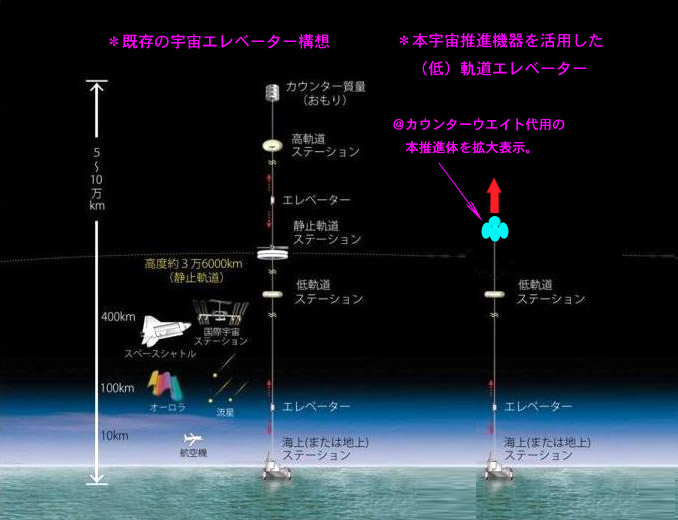
既存の宇宙エレベーターの建設計画では、何とも、静止衛星からのバランスを取るべく、それ相当のカウンター質量を要する為、 どうしても、全長約10万kmという(実現不可能と思える程の)途方もない長さと相成ってしまいますが、 いみじくも、本推進体を採用すれば、その半分以下の距離に収まり、 更に、これなど、テザー推進の一種たる(回転を要しない)スカイフックなどという派生方法にも応用が効き、 総じて、爆発の危険性が絶えない(原子力推進上等の)ロケットなど、全く不用となる 本格的な宇宙時代(尚安価な月旅行等)が到来すると云っても過言ではないでしょう・・・・・。
〜・〜・〜
以上、本サイト記載上等にかけて、多少たりとも、何らかのご疑義・疑念などあれば、
どうぞ、ご遠慮なく、是をNASAやJAXA等の方へお問い合わせの程を。
これからの宇宙航空機業界が、最も注目すべき外部及ぶ内部環境の革新的な変化等々。
現今の宇宙航空ビジネスに於ける諸々の課題と同業界に於ける近未来な新動向。